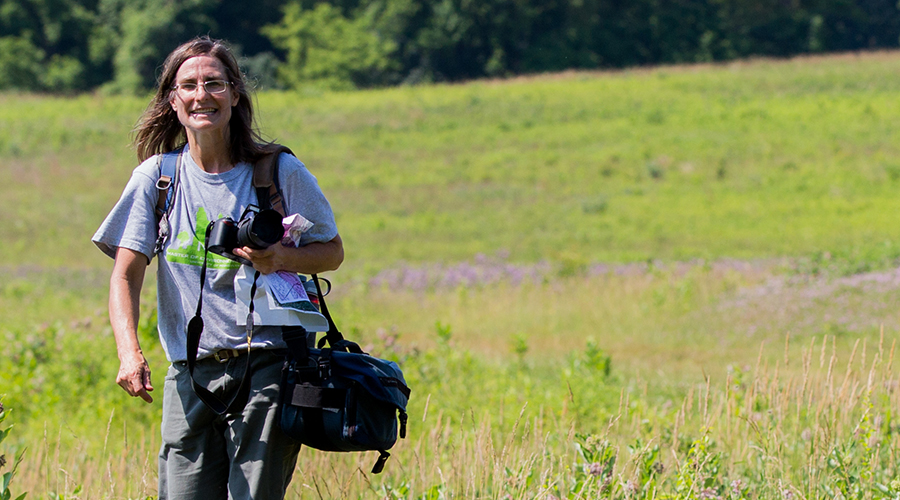
Pivoting to online classes to keep students safe during the COVID-19 pandemic introduced challenges—but also opportunities. Our innovative LPS community discovered new ways to stay connected.
Penn’s Master of Environmental Studies (MES) emphasizes hands-on, practical experience as well as academic rigor, so the stay-at-home orders in spring 2020 had a different impact on students planning to pursue internships and research in the field. Even so, the faculty and program team were well-equipped to make the transition to remote learning.
“This virtual world is not new in our field. This is normal,” says Dr. Yvette Bordeaux, Director of Professional Masters Programs in Earth and Environmental Science. Particularly for environmental consultants and organizations who work with global climate experts, meetings and collaborations frequently take place remotely. “I tell our students, you’re getting lots of great experience learning how to communicate with a group of people through mediums like Teams and Zoom and even the phone—and that’s great, because you’re going to be doing this in your career.”
While the faculty made the most of shared resources and University support to bring their course material online, some courses revolved around physical site visits and field demonstrations. For these, course instructors had to get creative. In Dr. Sally Willig’s fall Wetlands course, that meant limiting local field trips to small groups of students who could provide their own transportation—and filming their observations for those who couldn’t. At the same time, MES students who had returned home during the pandemic logged on from Kentucky, Florida, and even China and South Korea to upload their own video footage of field exploration. “The class literally had a global perspective, as students were in other parts of the world and could highlight their local landscapes,” says Dr. Willig. “Despite the fact we were scattered, it felt like a close-knit group. The students were very supportive of each other.”
Dr. Katera Moore, who teaches Meaningful Participation: Race, Place, and Environmental Justice this spring, is considering customizing the field observation assignment in her future courses. In a course focused on place-based environmental justice, her students spend time navigating a local neighborhood in person to develop a better understanding of that community’s resources and needs. “In a regular class, that would have been a walking tour. We would have gone somewhere as a class and walked around and reflected on our observations,” she says. “But I actually think it’s been more meaningful for students to pick their location.” Dr. Moore also observes that an online course platform lends itself to fruitful discussions where students submit their reflections to a forum instead of just to the instructor. “You can see what other students are thinking about,” she says. “This is generating questions, and there has been some cross-pollination.”
The online classroom is also more conducive to bringing in speakers and guest lecturers, providing students with a glimpse into environmental innovation in the real world as well as insights into how to pursue and develop a career in their field. John Miller, who taught Floodplain Management in a Changing Climate in the fall, was excited to introduce his students to a wider range of perspectives, methods, and solutions by bringing in colleagues from his field. “One of the blessings I’ve had in my career is knowing a network of people I could call on to discuss things I’m working on or investigating,” says Miller, who serves as Mitigation Liaison to the State of New Jersey for the Federal Emergency Management Agency (FEMA).
Of course, there were some learning experiences that couldn’t be translated as easily to online equivalents—especially early in the pandemic. Some summer internships were cancelled, and some courses had to be postponed, particularly if they taught field methods required for professional licensure. But even these challenges presented opportunities, suggests Bordeaux—namely, time. “We really pushed students over the summer to take advantage of the downtime: build their skills, get certified in something,” she says. Some students who were working on their capstones found that they couldn’t get access to the data or in-person opportunities they needed, so they shifted their focus to a different topic or type of research. “For a lot of folks, it was great to have more time to work on their project than they would normally have,” says Bordeaux. “They had time to focus on the research, explore what they had in terms of data, learn new software to help them build up their projects. We’re seeing some great projects come out of that.”
There were also plenty of opportunities for student engagement. “This year we had a group of students who became our graduate advisory board, and who really were interested in creating community along with us,” says Sally Cardy, Administrative Director of Professional Masters Programs in Earth and Environmental Science. The graduate advisory board hosted an orientation for new students as well as interactive sessions to keep students engaged. They also collected information from incoming students about their professional and academic interests, and coordinated with alumni and industry experts to bring in speakers whose work aligned with student interests. “We wanted to do something different every week,” says Bordeaux. “We had student financial services come in and talk about financial aid. The library came in and gave a great talk.” Cardy adds, “We had access to people from different organizations where students may get a job or an internship, and we were able to get a huge amount of information about all the things that people have asked us over the years—and then save it. It was really phenomenal.”
Ultimately, says Bordeaux, students pursuing environmental careers have to be prepared for anything. “You’ve got to be nimble. You’ve got to be able to work wherever you are, be adaptable to the situation, and make decisions on your own,” she says. “So it has been really good for students to learn how to do all of these things.” Miller, whose career in emergency management has given him first-hand experience in on-the-job adaptability and creative problem-solving, concurs. "At FEMA, we’ve had to adopt some things that we had never done before to keep going,” he says. “And that's basically what all of us are learning right now. We are going to be living adaptation as the course is going on.”
To read more about how MES faculty and students have adapted to the challenges of the past year, visit our MES in the Community page and browse recent stories.
To see how other College of Liberal and Professional Studies programs have met the challenges of learning during the pandemic, read “Challenge accepted: In Penn’s Organizational Dynamics Programs, students put their classroom lessons to work.”



